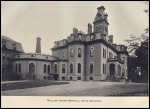Difference between revisions of "Portal:Featured Article Of The Week"
M-Explorer (talk | contribs) |
M-Explorer (talk | contribs) |
||
| (21 intermediate revisions by the same user not shown) | |||
| Line 1: | Line 1: | ||
{{FAformat | {{FAformat | ||
| − | |Title= | + | |Title= Willard State Hospital |
| − | |Image= | + | |Image= Willard_N_6.jpg |
|Width= 150px | |Width= 150px | ||
| − | |Body= In | + | |Body= In 1853, the site was acquired for the state's first agricultural college. The college - on 440 acres of farmland in the town of Ovid, "the geographical centre and Eden of the Empire State" - opened in December 1860, but it didn't last long. Within months, its president and most of the teachers and students marched off to fight in the Civil War, and the college never reopened. It was superseded by the new state university, established in Ithaca on land donated by state Senator Ezra Cornell. |
| − | + | Soon afterward, the site was earmarked for the Willard Asylum for the Insane, which would represent a second and major step toward transferring responsibility for the care of the mentally ill to the state. From colonial times, the care of insane persons had been a local function. Each county operated a poorhouse, or almshouse, wherein was indiscriminately lodged a hodgepodge of dependant persons: the mad, the feebleminded, the aged and crippled, drunks, epileptics and beggars. The almshouses provided custody and shelter, but "treatment" was not in their vocabulary. | |
| − | + | The first step toward state assumption of responsibility was the opening of the Utica Lunatic Asylum in 1843. Utica was established as a treatment facility. It was reserved for new, acute eases and was required by law to return to county custody any patient who was not discharged as recovered within two years. Still condemned to the almshouse were the incurables, who, contrary to the unreal expectations of early asylum enthusiasts, were the norm among the pauper lunatic class. Dorothea Dix, among others including the underfunded county superintendents of the poor, drew the Legislature's attention to the unspeakable plight of the chronically ill. [[Willard State Hospital|Click here for more...]] | |
}} | }} | ||
Revision as of 04:52, 9 June 2019
Featured Article Of The Week
Willard State Hospital
In 1853, the site was acquired for the state's first agricultural college. The college - on 440 acres of farmland in the town of Ovid, "the geographical centre and Eden of the Empire State" - opened in December 1860, but it didn't last long. Within months, its president and most of the teachers and students marched off to fight in the Civil War, and the college never reopened. It was superseded by the new state university, established in Ithaca on land donated by state Senator Ezra Cornell.
Soon afterward, the site was earmarked for the Willard Asylum for the Insane, which would represent a second and major step toward transferring responsibility for the care of the mentally ill to the state. From colonial times, the care of insane persons had been a local function. Each county operated a poorhouse, or almshouse, wherein was indiscriminately lodged a hodgepodge of dependant persons: the mad, the feebleminded, the aged and crippled, drunks, epileptics and beggars. The almshouses provided custody and shelter, but "treatment" was not in their vocabulary.
The first step toward state assumption of responsibility was the opening of the Utica Lunatic Asylum in 1843. Utica was established as a treatment facility. It was reserved for new, acute eases and was required by law to return to county custody any patient who was not discharged as recovered within two years. Still condemned to the almshouse were the incurables, who, contrary to the unreal expectations of early asylum enthusiasts, were the norm among the pauper lunatic class. Dorothea Dix, among others including the underfunded county superintendents of the poor, drew the Legislature's attention to the unspeakable plight of the chronically ill. Click here for more...
